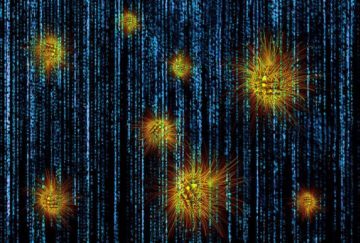Matthew Rozsa in Salon:
 Visualize, if you will, a group of bacteria cells. They are kind of silly looking, when you get right down to it: shaped like a sphere or a pill, sometimes covered in tiny hairs or spikes. While technically alive, it is hard to imagine them as being particularly intelligent, much less capable of storing information like artificially intelligent machines such as computers. Curiously, that’s exactly what a group of researchers just did: edited DNA inside individual bacteria cells in order to store digital data.
Visualize, if you will, a group of bacteria cells. They are kind of silly looking, when you get right down to it: shaped like a sphere or a pill, sometimes covered in tiny hairs or spikes. While technically alive, it is hard to imagine them as being particularly intelligent, much less capable of storing information like artificially intelligent machines such as computers. Curiously, that’s exactly what a group of researchers just did: edited DNA inside individual bacteria cells in order to store digital data.
A new paper by researchers at Columbia University reveals that they were able to modify the DNA of bacteria cells by inserting specific DNA sequences with encoded data that could be translated into the message “Hello world!” Specifically the DNA sequences were modified to represent the 0s and 1s used in binary code (the same code that is used in computers) and then assembled in various arrangements to correspond with letters of the English alphabet. The end result is that the words “hello” and “world” were written and encoded into the DNA of E. coli cells.
Just as the English alphabet has twenty-six letters that comprise it, DNA has four compounds that serve as the basis for the genetic code: adenine, cytosine, guanine and thymine. These building blocks that comprise DNA molecules can be modified to store “bits” of information. Two of the Columbia University scientists behind the new research — Ross McBee, a PhD candidate, and Sung Sun Yim, a postdoctoral fellow — explained to Salon by email that they modified the bacterial DNA code using a technology known as CRISPR/Cas9 genetic scissors (or CRISPR for short), which allows scientists to directly alter DNA. (The scientists who developed CRISPR technology won the Nobel Prize in Chemistry last year for their invention.)
More here.
